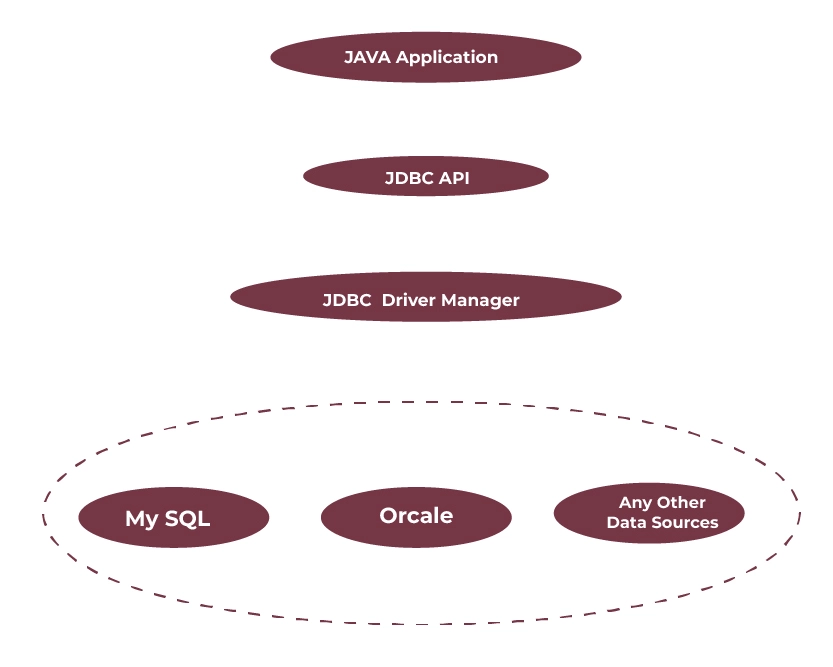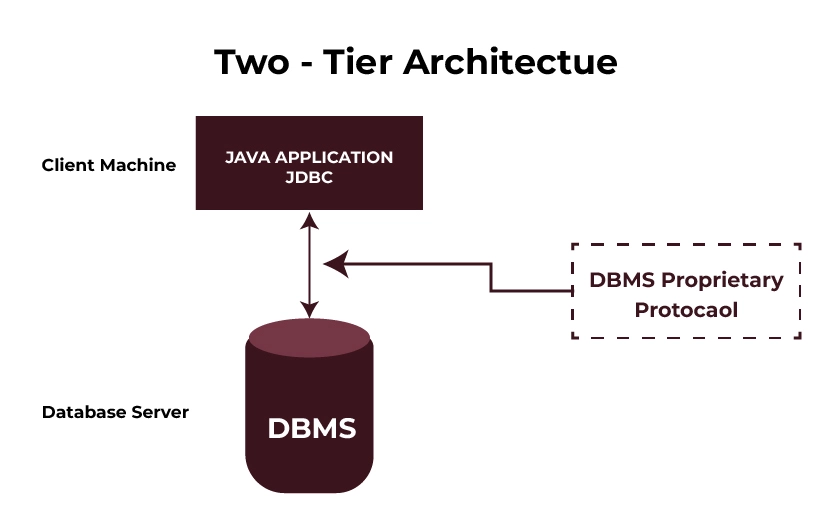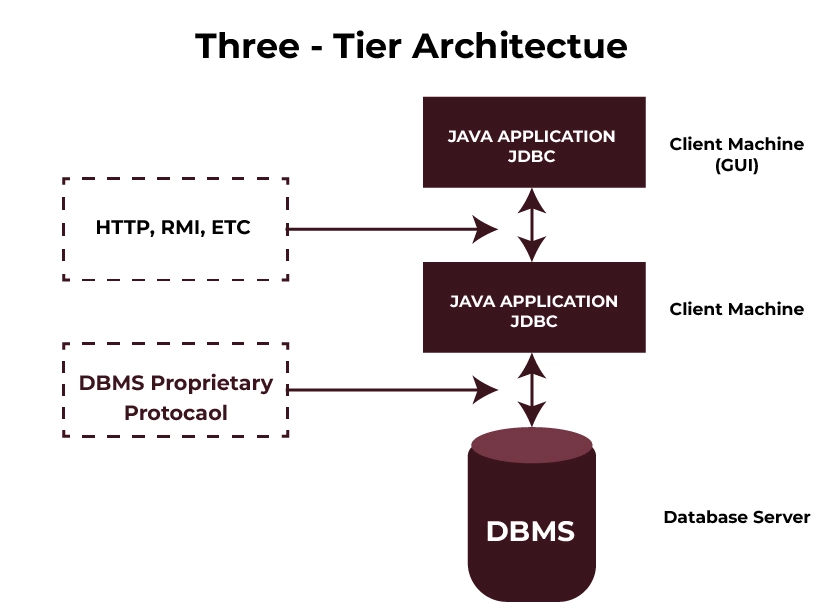Why is it always painful to connect your Java application with any database?
We all know that without a stable and working database connection, our application is only a bunch of code floating in the air.
But what is the best way to get this connection?
All will come from understanding JDBC (Java Database Connectivity) architecture.
JDBC architecture in Java is actually the bridge between your Java application and the data in your database.
Whether it be a simple project or some complex, enterprise-level system, your application will only smoothly converse with databases if you know JDBC inside and out.

Understanding the Purpose and Use Cases of JDBC
Why would anyone want to care about JDBC?
Well, here is the thing: every Java application that interacts with some sort of database requires a reliable method by which it can send and retrieve data.
In essence, JDBC translates our Java code into something the database understands. Now, let’s say that you are working on a Java application to maintain customer orders. Of course, you would have to store those orders, update them when necessary, query them, and sometimes delete them.
JDBC architecture in Java makes all this possible by letting our Java application connect with the database, execute SQL queries, and handle the data effectively.
But it’s not just about storing data.
JDBC is vital for any operation where our Java application needs to talk to a database.
Whether it’s a desktop app managing a local database or a large-scale enterprise system interfacing with multiple databases, JDBC has us covered.
Also Check: Java Tutorial for Beginners

POSTGRADUATE PROGRAM IN
Multi Cloud Architecture & DevOps
Master cloud architecture, DevOps practices, and automation to build scalable, resilient systems.
Core Components of JDBC and Their Roles
JDBC architecture in Java isn’t just one thing. It’s made up of several key components, each playing a crucial role in making our database interactions smooth and efficient.
Let’s break them down.
JDBC API: Classes, Methods, and Interfaces Overview
The JDBC API is the heart of JDBC.
It provides the tools we need to interact with our database.
It holds a set of interfaces and classes that are used to interact with the connections, perform SQL queries, and process the results.
Here’s what we’re working with:
- Connection Interface: This is where it all begins. We use it to establish a connection to our database.
- Statement Interface: Once we have a connection, this interface lets us create and execute SQL queries.
- ResultSet Interface: After executing a query, this interface helps us handle the data returned by the database.
- PreparedStatement Interface: This is like the Statement interface but with extra features, especially useful for executing SQL queries with parameters.
- CallableStatement Interface: This one’s for when we need to execute stored procedures in the database.
JDBC Driver Manager: Establishing Database Connections
The JDBC Driver Manager is like the gatekeeper. It manages the drivers needed to connect to different databases.
When it is asked to connect to a database, it searches for an appropriate driver and gets the connection ready.
Here goes how it happens:
- We load the driver using Class.forName().
- Then, we call DriverManager.getConnection() to establish the connection.
Think of it like this: the Driver Manager is the taxi service, and the drivers are the taxis. We tell the Driver Manager where we want to go, and it finds the right taxi- driver- to take us there.
JDBC Test Suite: Ensuring Database Operations Integrity
No one likes a buggy application, especially when it involves data.
That’s where the JDBC Test Suite comes in. This tool helps us test the operations our JDBC code performs on the database.
For example, we can use it to:
- Verify that our insertions, deletions, and updates are working as expected.
- Ensure that our queries are returning the correct data.
This way, we can catch any issues early and avoid headaches later on.
JDBC-ODBC Bridge: Legacy Support and Modern Alternatives
Next, the JDBC-ODBC Bridge: this is a rather older tool, but it finds its place here.
The JDBC-ODBC Bridge was a way to connect JDBC with the ODBC (Open Database Connectivity) drivers. We could access databases through the ODBC layer, which at that time was handy.
It’s outdated now, and in Java 8, it was removed.
Today, instead of the bridge, we rely directly on vendor-specific drivers. These are more efficient and faster, not to mention much better adapted to today’s applications.
Type of JDBC Architecture in Java: Two-Tier versus Three-Tier Models
Why would we care if we are using a two-tier or three-tier architecture for our Java application? That has everything to do with the ways in which we can connect our code to a database and pass the data flow.
Now, let’s break these down and see where each fits best.
Two-Tier JDBC Architecture in Java: Direct Communication Between Java Applications and Databases

First, we have the two-tier architecture, the simple path. Here, our Java application talks to the database directly.
In other words, it is one-on-one communication. We send a query, and the database responds with results.
This kind of setup works just great for small applications where everything occurs on one machine or in a small network.
But here’s the thing.
Because of the strong coupling between the application and the database, scaling becomes complex.
Imagine thousands of end-users connecting directly to the very same database. Performance is going to be affected. But for small- to medium-sized projects, the two-tier model works just great.
We connect to the database using JDBC, send our SQL queries there, and get the data back without any middleman.
This simplicity makes it rather easy to set up and manage.
Three-Tier JDBC Architecture in Java: Role of the Middle Tier in Enterprise Applications

Now, let’s talk about the three-tier architecture.
This model adds a middle tier between our Java application and the database.
Think of it as a buffer or a control centre.
When we use a three-tier architecture, our Java application sends requests to the middle tier. The middle tier processes these requests, interacts with the database and then sends the results back to the application.
Why add this extra layer? It’s all about control, security, and scalability.
The middle tier can handle multitasking, including transaction management, enforcement of security policy, and even load balancing among databases.
This model will provide a complete revolution to enterprise applications on a large scale.
Using this model, we can handle more traffic, keep our sensitive data secure, and be sure our application will not get slow when the load increases. Moreover, updating or changing any part of the system does not need to affect the rest of the system.
Comparing the Use Cases and Advantages of Two-Tier and Three-Tier JDBC Models
Which model, then, should we use? Well, that depends on the needs of our application.
If we are developing a very small, local application where we need negligible traffic, then the two-tier model is the one for us. That is because the model is basic and easy to administer; we do not want to complicate things unnecessarily.
The three-tier model is again best for dealing with multi user handling, management of transactions, and data security for large-scale applications.
It offers more control, better performance under load, and flexibility in managing our application.
Here’s a quick comparison:
| Feature | Two-Tier Model | Three-Tier Model |
| Communication | Direct communication with the database | Communication via a middle tier |
| Scalability | Limited scalability | High scalability, better for large applications |
| Security | Basic security | Enhanced security with middle-tier controls |
| Performance | Suitable for small-scale applications | Optimised for high-load environments |
| Complexity | Simple setup | More complex but offers better control |
Key Interfaces and Classes in JDBC API for Database Connectivity
Let’s dive into the tools we need to build these architectures.
JDBC provides several interfaces and classes that help us connect our Java application to the database.
Each plays a specific role in making sure our data gets where it needs to go.
Here’s what we use:
- Connection Interface: We start by establishing a connection to the database. This interface is our gateway.
- Statement Interface: Once connected, this interface lets us create and execute SQL queries.
- ResultSet Interface: After executing a query, we use this interface to handle the data returned by the database.
- PreparedStatement Interface: Similar to Statement, but with added features for executing parameterised queries.
- CallableStatement Interface: This one’s for running stored procedures in the database.
These interfaces form the backbone of our JDBC operations. Understanding how to use them effectively is key to building a strong JDBC architecture.
Also Read: Features of Java Programming

82.9%
of professionals don't believe their degree can help them get ahead at work.
Step-by-Step Guide to Creating a Simple JDBC Application
Let’s walk through building a simple JDBC application that connects to a database, executes a query, and handles the results.
We’ll be using MySQL for this example.
- Loading the JDBC Driver for Database Communication
First, we need to load the JDBC driver. This driver acts as the translator between our Java application and the database.
We do this with the following code:
Class.forName("com.mysql.jdbc.Driver");
This line ensures that our application knows which driver to use when connecting to the database.
Establishing a Connection with the Database
Next, we establish the connection. This step is like opening a door to the database.
Replace “mydatabase”, “username”, and “password” with your actual database name and credentials.
Crafting SQL Queries and Executing Them Using JDBC
Now, let’s create an SQL query. We’ll use the Statement interface to execute this query. Here’s a simple example:
Statement stmt = con.createStatement();
String sql = "SELECT * FROM students WHERE grade > 75";
ResultSet rs = stmt.executeQuery(sql);
This query retrieves all students with grades above 75.
Handling Results and Closing Connections Safely
After executing the query, we need to handle the results. We use the ResultSet interface for this:
while (rs.next()) {
int id = rs.getInt("id");
String name = rs.getString("name");
int grade = rs.getInt("grade");
System.out.println("ID: " + id + ", Name: " + name + ", Grade: " + grade);
}
This loop goes through each row of results and prints the student details. Finally, we close the connection to avoid any resource leaks:
rs.close();
stmt.close();
con.close();
Example: Building a Simple JDBC Application in Java
import java.sql.Connection;
import java.sql.DriverManager;
import java.sql.PreparedStatement;
import java.sql.ResultSet;
import java.sql.Statement;
public class JDBCDemo {
public static void main(String[] args) {
// Step 1: Load the JDBC Driver
try {
Class.forName("com.mysql.cj.jdbc.Driver");
// Step 2: Establish the Connection
Connection con = DriverManager.getConnection(
"jdbc:mysql://localhost:3306/mydatabase", "username", "password");
// Step 3: Create and Execute a SQL Query
Statement stmt = con.createStatement();
String sql = "SELECT * FROM students WHERE grade > 75";
ResultSet rs = stmt.executeQuery(sql);
// Step 4: Process the ResultSet
while (rs.next()) {
int id = rs.getInt("id");
String name = rs.getString("name");
int grade = rs.getInt("grade");
System.out.println("ID: " + id + ", Name: " + name + ", Grade: " + grade);
}
// Step 5: Insert a New Record Using PreparedStatement
String insertSQL = "INSERT INTO students (name, grade) VALUES (?, ?)";
PreparedStatement pstmt = con.prepareStatement(insertSQL);
pstmt.setString(1, "John Doe");
pstmt.setInt(2, 85);
pstmt.executeUpdate();
// Step 6: Retrieve and Display the Inserted Record
String selectSQL = "SELECT * FROM students WHERE name = 'John Doe'";
ResultSet rs2 = stmt.executeQuery(selectSQL);
while (rs2.next()) {
System.out.println("Inserted - ID: " + rs2.getInt("id") +
", Name: " + rs2.getString("name") +
", Grade: " + rs2.getInt("grade"));
}
// Step 7: Close All Resources
rs2.close();
rs.close();
pstmt.close();
stmt.close();
con.close();
} catch (Exception e) {
e.printStackTrace();
}
}
}
Challenges and Best Practices in JDBC Implementation
Why do so many developers run into problems when using JDBC architecture in Java? It’s because working with databases can be tricky. Something as minor as a mistake can create big problems, ranging from performance issues to data loss, even to security vulnerabilities. Let’s delve into some of the common problems with JDBC and how we can overcome them.
1. Connection Leaks
One of the biggest problems we face with JDBC architecture in Java is connection leaks. This happens when we forget to close our database connections properly. Over time, these open connections can pile up, leading to performance degradation and even application crashes. How to Avoid It:
- Always close your Connection, Statement, and ResultSet objects in a final block.
- Better yet, use a try-with-resources statement to automatically close resources.
2. SQL Injection
SQL injection is a serious security risk where attackers can manipulate your SQL queries. If we’re not careful, our application can be exposed to data theft or destruction.
How to Avoid It:
- Use PreparedStatement instead of Statement to avoid SQL injection.
- Never concatenate user inputs directly into SQL queries.
3. Poor Performance Due to Inefficient Queries
Inefficient queries can slow down our application significantly. Running complex queries without proper indexing or using too many database connections can drag down performance.
How to Avoid It:
- Optimise your SQL queries.
- Use indexes where appropriate.
- Limit the number of connections your application opens to the database.
4. Error Handling
Improper error handling can lead to silent failures. If our application doesn’t handle exceptions well, it might keep running with broken functionality.
How to Avoid It:
- Always handle exceptions properly.
- Log errors for debugging and alerting purposes.
5. Handling Large Data Sets
When dealing with large data sets, loading everything into memory at once can crash the application.
How to Avoid It:
- Use pagination techniques to fetch data in chunks.
- Limit the amount of data processed in each query.
Tips for Optimising JDBC Performance in High-Load Environments
How can we ensure our JDBC application runs smoothly even under heavy load? Here are some proven tips:
- Connection Pooling: Don’t open and close connections repeatedly. Use a connection pool to reuse connections and reduce overhead.
- Batch Processing: If we need to execute multiple queries, batch them together to minimise round-trips to the database.
- Use PreparedStatement: Reuse prepared statements to improve performance and prevent SQL injection.
- Caching: Cache frequently accessed data to reduce database hits. But be careful with cache invalidation.
- Optimise Queries: Ensure your queries are optimised for performance. Use indexes, avoid unnecessary columns, and consider query execution plans.
By following these practices, we can significantly improve the performance and reliability of our JDBC applications.
Modern Alternatives to JDBC-ODBC Bridge and Their Implementation
Transitioning from Legacy Drivers to Vendor-Specific Solutions
Instead of relying on the old JDBC-ODBC Bridge, we should use vendor-specific drivers. These drivers are designed to work directly with specific databases like MySQL, PostgreSQL, or Oracle. They’re faster, more secure, and better supported.
Steps to Transition:
- Identify the database you’re using.
- Download and configure the appropriate JDBC driver.
- Update your connection strings and code to use the new driver.
Best Practices for Choosing the Right JDBC Driver
Choosing the right JDBC driver isn’t just about compatibility. We need to consider performance, security, and support.
Here’s What to Look For:
- Official Support: Use drivers that are officially supported by the database vendor.
- Community Support: Check for active communities or forums that can help with issues.
- Performance: Look for benchmarks or performance reports.
- Security: Ensure the driver supports secure connections and modern encryption standards.
Switching to a modern, vendor-specific driver can give our application a significant performance boost and improve security.
Conclusion
Mastery of JDBC architecture in Java is indispensable while developing robust and scalable applications in Java.
Understanding the core components of JDBC API and Driver Manager allows us, in turn, to connect our applications to databases efficiently.
Architecture model selection can greatly impact both performance and scalability, be it two-tier for simplicity or three-tier for greater control.
Clearing connection leaks, SQL injections, and other common issues will go a long way in making code secure and performant.
Adherence to modern practices regarding vendor-specific drivers and query performance optimisation rounds up our applications to make them functional, robust, and future-proof.
What are the main differences between two-tier and three-tier JDBC architecture models?
- The two-tier model connects directly to the database. As such, it is simpler but less scalable.
- The three-tier model adds a middle tier that gives it more scalability and security.
Why was the JDBC-ODBC Bridge deprecated?
How does connection pooling improve JDBC performance?
Does JDBC support non-relational databases?
What is the danger of not using the PreparedStatement in JDBC?
Updated on November 19, 2024
